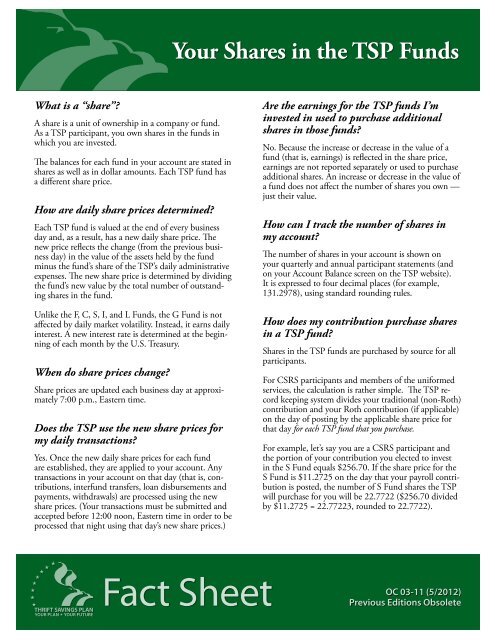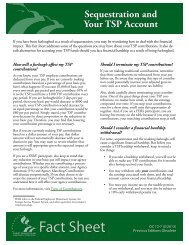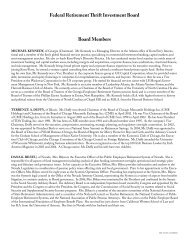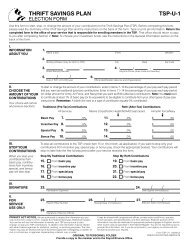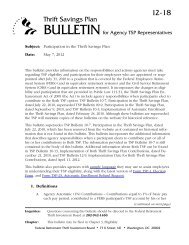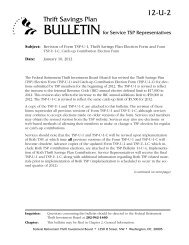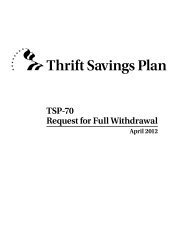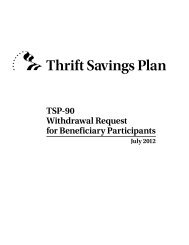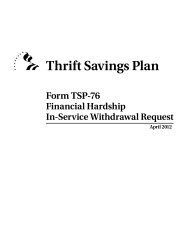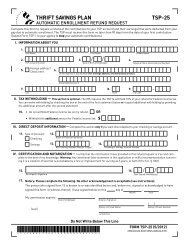Fact Sheet: Your Shares in the TSP Funds - Thrift Savings Plan
Fact Sheet: Your Shares in the TSP Funds - Thrift Savings Plan
Fact Sheet: Your Shares in the TSP Funds - Thrift Savings Plan
You also want an ePaper? Increase the reach of your titles
YUMPU automatically turns print PDFs into web optimized ePapers that Google loves.
What is a “share”?<br />
A share is a unit of ownership <strong>in</strong> a company or fund.<br />
As a <strong>TSP</strong> participant, you own shares <strong>in</strong> <strong>the</strong> funds <strong>in</strong><br />
which you are <strong>in</strong>vested.<br />
The balances for each fund <strong>in</strong> your account are stated <strong>in</strong><br />
shares as well as <strong>in</strong> dollar amounts. Each <strong>TSP</strong> fund has<br />
a different share price.<br />
How are daily share prices determ<strong>in</strong>ed?<br />
Each <strong>TSP</strong> fund is valued at <strong>the</strong> end of every bus<strong>in</strong>ess<br />
day and, as a result, has a new daily share price. The<br />
new price reflects <strong>the</strong> change (from <strong>the</strong> previous bus<strong>in</strong>ess<br />
day) <strong>in</strong> <strong>the</strong> value of <strong>the</strong> assets held by <strong>the</strong> fund<br />
m<strong>in</strong>us <strong>the</strong> fund’s share of <strong>the</strong> <strong>TSP</strong>’s daily adm<strong>in</strong>istrative<br />
expenses. The new share price is determ<strong>in</strong>ed by divid<strong>in</strong>g<br />
<strong>the</strong> fund’s new value by <strong>the</strong> total number of outstand<strong>in</strong>g<br />
shares <strong>in</strong> <strong>the</strong> fund.<br />
Unlike <strong>the</strong> F, C, S, I, and L <strong>Funds</strong>, <strong>the</strong> G Fund is not<br />
affected by daily market volatility. Instead, it earns daily<br />
<strong>in</strong>terest. A new <strong>in</strong>terest rate is determ<strong>in</strong>ed at <strong>the</strong> beg<strong>in</strong>n<strong>in</strong>g<br />
of each month by <strong>the</strong> U.S. Treasury.<br />
When do share prices change?<br />
Share prices are updated each bus<strong>in</strong>ess day at approximately<br />
7:00 p.m., Eastern time.<br />
Does <strong>the</strong> <strong>TSP</strong> use <strong>the</strong> new share prices for<br />
my daily transactions?<br />
Yes. Once <strong>the</strong> new daily share prices for each fund<br />
are established, <strong>the</strong>y are applied to your account. Any<br />
transactions <strong>in</strong> your account on that day (that is, contributions,<br />
<strong>in</strong>terfund transfers, loan disbursements and<br />
payments, withdrawals) are processed us<strong>in</strong>g <strong>the</strong> new<br />
share prices. (<strong>Your</strong> transactions must be submitted and<br />
accepted before 12:00 noon, Eastern time <strong>in</strong> order to be<br />
processed that night us<strong>in</strong>g that day’s new share prices.)<br />
THRIFT SAVINGS PLAN<br />
YOUR PLAN YOUR FUTURE <strong>Fact</strong><br />
<strong>Your</strong> <strong>Shares</strong> <strong>in</strong> <strong>the</strong> <strong>TSP</strong> <strong>Funds</strong><br />
<strong>Sheet</strong> OC<br />
Are <strong>the</strong> earn<strong>in</strong>gs for <strong>the</strong> <strong>TSP</strong> funds I’m<br />
<strong>in</strong>vested <strong>in</strong> used to purchase additional<br />
shares <strong>in</strong> those funds?<br />
No. Because <strong>the</strong> <strong>in</strong>crease or decrease <strong>in</strong> <strong>the</strong> value of a<br />
fund (that is, earn<strong>in</strong>gs) is reflected <strong>in</strong> <strong>the</strong> share price,<br />
earn<strong>in</strong>gs are not reported separately or used to purchase<br />
additional shares. An <strong>in</strong>crease or decrease <strong>in</strong> <strong>the</strong> value of<br />
a fund does not affect <strong>the</strong> number of shares you own —<br />
just <strong>the</strong>ir value.<br />
How can I track <strong>the</strong> number of shares <strong>in</strong><br />
my account?<br />
The number of shares <strong>in</strong> your account is shown on<br />
your quarterly and annual participant statements (and<br />
on your Account Balance screen on <strong>the</strong> <strong>TSP</strong> website).<br />
It is expressed to four decimal places (for example,<br />
131.2978), us<strong>in</strong>g standard round<strong>in</strong>g rules.<br />
How does my contribution purchase shares<br />
<strong>in</strong> a <strong>TSP</strong> fund?<br />
<strong>Shares</strong> <strong>in</strong> <strong>the</strong> <strong>TSP</strong> funds are purchased by source for all<br />
participants.<br />
For CSRS participants and members of <strong>the</strong> uniformed<br />
services, <strong>the</strong> calculation is ra<strong>the</strong>r simple. The <strong>TSP</strong> record<br />
keep<strong>in</strong>g system divides your traditional (non-Roth)<br />
contribution and your Roth contribution (if applicable)<br />
on <strong>the</strong> day of post<strong>in</strong>g by <strong>the</strong> applicable share price for<br />
that day for each <strong>TSP</strong> fund that you purchase.<br />
For example, let’s say you are a CSRS participant and<br />
<strong>the</strong> portion of your contribution you elected to <strong>in</strong>vest<br />
<strong>in</strong> <strong>the</strong> S Fund equals $256.70. If <strong>the</strong> share price for <strong>the</strong><br />
S Fund is $11.2725 on <strong>the</strong> day that your payroll contribution<br />
is posted, <strong>the</strong> number of S Fund shares <strong>the</strong> <strong>TSP</strong><br />
will purchase for you will be 22.7722 ($256.70 divided<br />
by $11.2725 = 22.77223, rounded to 22.7722).<br />
03-11 (5/2012)<br />
Previous Editions Obsolete
If you are a FERS participant, <strong>the</strong> process used to calculate<br />
<strong>the</strong> number of shares purchased by your contributions<br />
is more <strong>in</strong>volved because your contributions<br />
are broken down by traditional (non-Roth) employee<br />
contributions, <strong>the</strong> Roth employee contributions, <strong>the</strong><br />
Agency Automatic (1%) Contribution, and <strong>the</strong> Agency<br />
Match<strong>in</strong>g Contribution. Aga<strong>in</strong>, <strong>the</strong> <strong>TSP</strong> purchases<br />
shares for each source separately. Therefore, for each<br />
fund <strong>in</strong> which you are <strong>in</strong>vested, <strong>the</strong> contribution amount<br />
from each source gets divided by <strong>the</strong> daily share price.<br />
Because of round<strong>in</strong>g rules, when <strong>the</strong> shares purchased<br />
from all sources are added toge<strong>the</strong>r, you could end up<br />
with slightly more or slightly fewer shares than if you<br />
had simply divided your total overall contribution by<br />
<strong>the</strong> fund’s share price.<br />
Example:<br />
Contribution<br />
Source<br />
Amount<br />
Share<br />
Price<br />
Number<br />
of <strong>Shares</strong><br />
Purchased<br />
Before<br />
Round<strong>in</strong>g<br />
Number<br />
of <strong>Shares</strong><br />
Purchased<br />
After<br />
Round<strong>in</strong>g<br />
Employee<br />
Traditional<br />
(non-Roth): $147.25 ÷ $14.2803 = 10.31141 10.3114<br />
Employee<br />
Roth: 147.25 ÷ 14.2803 = 10.31141 10.3114<br />
Agency<br />
Automatic<br />
(1%):<br />
Agency<br />
58.90 ÷ 14.2803 = 4.12456 4.1246<br />
Match<strong>in</strong>g: 235.60 ÷ 14.2803 = 16.49825 16.4983<br />
Total: $589.00 41.2457<br />
In <strong>the</strong> previous example, a FERS participant’s contribution<br />
to <strong>the</strong> C Fund is calculated by source. The sum of <strong>the</strong><br />
rounded shares purchased through all sources is 41.2457.<br />
This represents a difference of .0001 from <strong>the</strong> result you<br />
would get by simply divid<strong>in</strong>g <strong>the</strong> participant’s total overall<br />
contribution ($589.00) by <strong>the</strong> share price (14.2803) to arrive<br />
at 41.2456 ($589.00 ÷ $14.2803 = 41.24563 shares,<br />
rounded to 41.2456 shares). Note: If you are a CSRS<br />
employee or a member of <strong>the</strong> uniformed services and you<br />
have employee contributions to a traditional (non-Roth)<br />
balance and a Roth balance, you may also be affected by<br />
<strong>the</strong> round<strong>in</strong>g rules.<br />
What is dollar-cost averag<strong>in</strong>g?<br />
Dollar-cost averag<strong>in</strong>g is a system of purchas<strong>in</strong>g shares at<br />
regular <strong>in</strong>tervals with a fixed dollar amount. The number<br />
of shares may change with each purchase, based on<br />
<strong>the</strong> share price at <strong>the</strong> time of purchase. The fixed dollar<br />
amount buys more shares when <strong>the</strong> share price is low and<br />
fewer shares when <strong>the</strong> share price is high. If you are <strong>in</strong>vest<strong>in</strong>g<br />
regularly <strong>in</strong> <strong>the</strong> <strong>TSP</strong> funds through payroll deductions,<br />
you are already dollar-cost averag<strong>in</strong>g.<br />
How does dollar-cost averag<strong>in</strong>g benefit me?<br />
The example below illustrates how dollar-cost averag<strong>in</strong>g<br />
benefits you.<br />
Contri-<br />
bution<br />
Investment<br />
Amount<br />
Share<br />
Price<br />
<strong>Shares</strong><br />
Purchased<br />
1 $200 $50 4<br />
2 $200 $40 5<br />
3 $200 $20 10<br />
4 $200 $40 5<br />
Totals $800 $150 24<br />
• Average share price of <strong>the</strong> four contributions: $150 ÷ 4 = $37.50<br />
• Participant’s cost per share: $800 ÷ 24 = $33.33<br />
In this example, you made regular contributions of $200.<br />
S<strong>in</strong>ce <strong>the</strong>re was a different share price each time you<br />
made a contribution, you received a different number of<br />
shares for each $200 contribution you made. With your<br />
four contributions, you <strong>in</strong>vested a total of $800 and purchased<br />
a total of 24 shares. <strong>Your</strong> average share price (that<br />
is, <strong>the</strong> sum of <strong>the</strong> four share prices divided by <strong>the</strong> number<br />
of contributions, or $150 ÷ 4) was $37.50. However,<br />
because of dollar-cost averag<strong>in</strong>g, your cost per share was<br />
only $33.33 — <strong>the</strong> sum of your contributions divided by<br />
<strong>the</strong> number of shares you purchased ($800 ÷ 24).<br />
2


